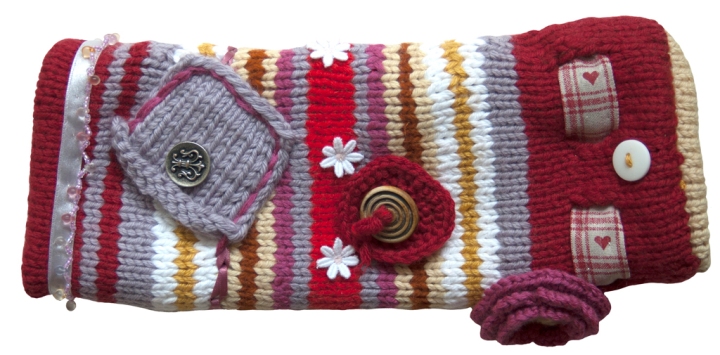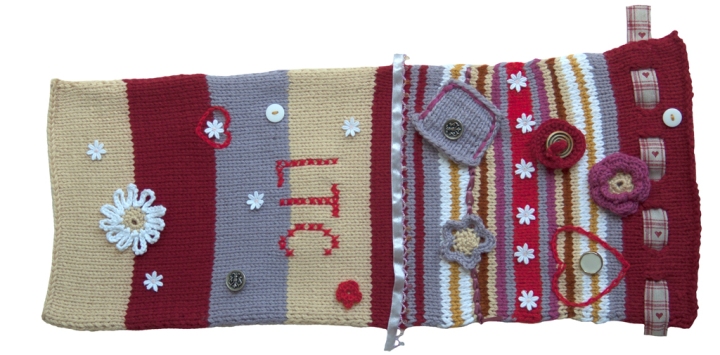Twiddle Muff: Knitting for Dementia
Have you ever heard of twiddle muffs? Nor did I, until last Friday! Please read on, if interested.
As this week (17–23 May 2015) is the Dementia Awareness Week, I decided to have a go in making my first twiddle muff in order to support a patient with dementia as part of the Forget-Me-Not project carried out by various NHS Foundation Trusts across the UK (for your local one see Dementia Action Alliance) asking knitters to contribute into. I am not a professional knitter, but I use various craft techniques using yarn in the making of my illustrations and art projects. Knitting and crocheting reconnect me to the roots of my earlier female generations, so I am very grateful to my mum and grandmother who taught me all these ‘skills-for-life’ when I was a child, so that I am now able to make this contribution to a sad but beautiful project of LTC – Love, Tender and Care.
What are Twiddle Muffs?
Twiddle muffs, known by some as twiddle mitts, were first created by Margaret Light [The Guardian]. Margaret developed them for her grandmother, Lily, who, as she grew older and her eyesight began to deteriorate, could no longer be as creative and productive with her hands as she had been all her life. “The Twiddle Muff satisfied her need to keep her hands warm and busy,” Margaret says. “She enjoyed it so much that it was on her lap constantly.” [Best Alzheimer’s Products]
According to Bradford Teaching Hospital (the link has the pattern & instructions), twiddle muffs are knitted hand muffs using various left-over yarn and being decorated with interesting bits and bobs attached inside and out. “They have been designed and developed to provide simple stimulation for active hands while promoting increased flexibility and brain stimulation.” Furthermore, Royal Devon and Exeter Hospital say that people with dementia “often have restless hands and like to have something to keep their hands occupied.” The twiddle muff “provides a wonderful source of visual, tactile and sensory stimulation and at the same time keeping hands snug and warm.”
Not only is, as recent studies have shown, the craft of knitting a therapy for depression – depression is one of the risk factors for developing dementia – but I also learn from Alzheimer’s Society that people with dementia remain involved in the community through knitting. As Adele Lacy, Dementia Support Worker, who runs Knit2gether group, says:
“I thought of knitting because, even when people have forgotten everything else, it is an automatic skill which never goes. People might not be able to do a lot of things but knitting is something they can still remember and it is great for the members to see a finished product and think ‘I did that’.”
Dedication of my Twiddlemuff
To me, it is impossible to imagine all the harrowing emotions charged, both, from the perspective of the diagnosed patient seeing one’s own inner decay as the illness progresses and from the perspective of his or her family. I have recently watched Julianne Moore’s outstanding performance in Still Alice, playing the role of a linguistics professor diagnosed with Alzheimer’s. The film is so emotionally powerful, shown through the eyes of someone, who faces “a harrowing challenge as this terminal degenerative neurological ailment slowly progresses to an inevitable conclusion” that we, survivors of the afflicted, all dread.
Also, over the last few years, I have witnessed how my very close friend of mine (and his family) was coping and was emotionally affected by his father’s Alzheimer’s, who was given full care at home with all LTC from the onset of the diagnosis to his recent death. I, therefore, thought I would dedicate my twiddle muff in the memory of my friend’s father. I only wished I had known about these twiddle muffs earlier!
 The Story in the Making of my Twiddle Muff
The Story in the Making of my Twiddle Muff
As an image creator, often working according to briefs, I enjoy opportunities where I can experiment without rational thinking! I love building up stories that take me to the unknown, as I am interested in how different stories, through recycling and collaging, come together to make a new narrative. For this kind of experimentation, I keep various kinds of boxes containing ‘bits and bobs’ – a Wunderkammer of history when things get pulled out!
As my friend and his family could not stop giving all the LTC to his father right to the end, for which I admired them so much, I thought that the overall design for my twiddle muff needed to express all that. I added a cross-stitched ‘LTC’ on the inside right at the end, but the overall design, however, really began to develop from the red and white striped ribbon with hearts before the base was even finished. The ribbon came with a Christmas present – a home-made jar of pickled herring –, given to me by my Danish colleague in 2007, and made and beautifully wrapped by her mum. In addition to the hearts, the reds became the centre to the colour scheme – also, because I wanted to include the left-over wool in bright red that my mum used to knit a striped jumper for me, which I wore when I started school back in the mid-70s! It is here used as a central stripe and also for stitched outlined hearts.
Furthermore, although a flower motive – daisies, fuchsia and, needless to say, most importantly, a forget-me-not – is more appropriate for a female patient, my friend’s dad was a very keen gardener, so it does make sense, after all, to add a touch of beauty from nature. Last, as the act of knitting is paramount to this LTC cause – to knit for the patients and the patients to knit –, it is important to pass such skills to younger generations as knitting is an automatic skill that never goes away. As I taught my little niece a stocking stitch a few years ago and as the twiddle muff is meant to be embellished with buttons among many other things, I added one button, which I had to remove from her first-communion dress! Although she and buttons are not best friends, she found it rather amusing that her ‘unlikable’ friend found its prominent place in the middle of the big heart!
As patients with dementia love hearing stories being told, I decided at the end to add a pocket in order to carry a note with all these amusing anecdotes in the making of his or her new twiddle muff! Of course, I shall omit my friend’s dad’s story. R.I.P.



4 comments